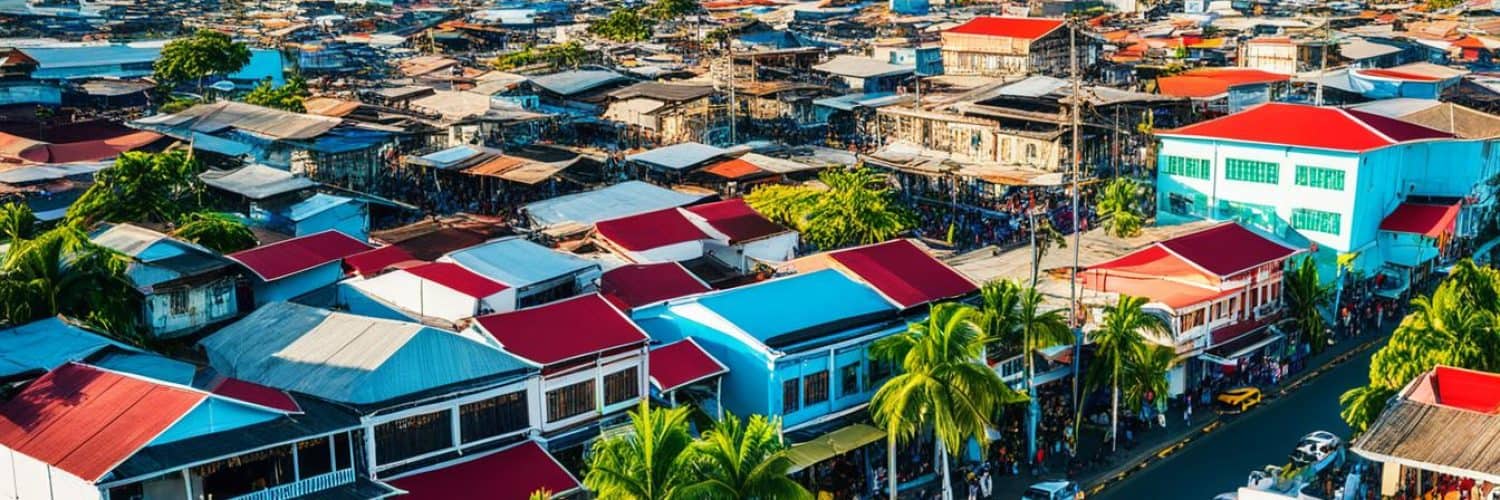Tacloban City, located near Samar, is a captivating destination brimming with historical significance and rich culture. As the capital of Leyte province, Tacloban serves as the gateway to other key cities in Eastern Visayas. The region is known for its monumental and historic structures, pristine beaches, and interesting sights. From Leyte’s role in World War II to the iconic San Juanico Bridge, there is much to explore and discover in Tacloban City.
Key Takeaways
- Tacloban City in Samar, Philippines, is a destination with rich historical significance.
- Discover Leyte’s role in World War II and visit the Leyte Landings memorials.
- Experience the marvel of the San Juanico Bridge, the longest bridge in the Philippines.
- Explore the natural beauty of Biri Island and its stunning rock formations.
- Immerse yourself in Tacloban’s cultural heritage and religious traditions.
Leyte: A Land Steeped in History
Leyte, the largest province in the Eastern Visayas region, is a treasure trove of historical significance. Its capital city, Tacloban, is home to remarkable landmarks that showcase the rich history of the province.
MacArthur Memorial Landing Park
One of the notable attractions in Tacloban is the MacArthur Memorial Landing Park. This park commemorates the historic return of General Douglas MacArthur to the Philippines during World War II. The park features impressive statues depicting MacArthur and his entourage, providing visitors with a glimpse into this significant moment in history.
Sto. Niño Shrine and Heritage Museum
For those interested in the cultural heritage of Leyte, the Sto. Niño Shrine and Heritage Museum is a must-visit destination. This former rest house of the Marcos family has been transformed into a museum that showcases their collection of art and artifacts. Visitors can explore the museum and admire the rich cultural heritage preserved within its walls.
Leyte Provincial Capitol
An architectural gem in Tacloban is the Leyte Provincial Capitol. This impressive building boasts neoclassical architecture and breathtaking historical bas reliefs. A visit to the Leyte Provincial Capitol provides visitors with a deeper understanding of the province’s history and the integral role it has played in shaping the region.
These landmarks in Leyte offer a glimpse into the province’s vibrant past and provide a deeper appreciation for its rich history. Whether exploring the MacArthur Memorial Landing Park, immersing oneself in the cultural heritage of the Sto. Niño Shrine and Heritage Museum, or marveling at the architectural beauty of the Leyte Provincial Capitol, there is no shortage of historical wonders to discover in Leyte and Tacloban.
San Juanico Bridge: A Structural Marvel
As one traverses the picturesque landscapes of Tacloban City and Samar in the Philippines, they will encounter the awe-inspiring San Juanico Bridge, an architectural masterpiece that connects the two islands. Spanning a whopping distance of 2.162 kilometers, this iconic bridge holds the distinction of being the longest bridge in the entire country.
What sets the San Juanico Bridge apart is not just its impressive length, but also its unique design. When viewed from above, the bridge resembles the letters “S” and “L,” representing the initials of Samar and Leyte, the two islands it binds together. This design element adds to the bridge’s allure and makes it a true visual spectacle.
This remarkable structure, also known as the Marcos Bridge, serves as a testament to the ingenuity and ambition of former Philippine President Ferdinand Marcos. Built during his presidency, the San Juanico Bridge is a symbol of his love for his wife, Imelda Marcos, whose family hails from Leyte.
Despite its age, the San Juanico Bridge has withstood the test of time and weathered numerous typhoons, including the devastating Super Typhoon Yolanda. Its resilience and stability are a testament to the engineering prowess involved in its construction.
Interesting Facts about the San Juanico Bridge:
- The bridge was completed in the year 1973 and opened to the public on July 2, 1973.
- The construction of the San Juanico Bridge was a joint effort between the Philippine government and the Japanese International Cooperation Agency.
- The bridge has become an iconic landmark and tourist attraction, offering visitors panoramic views of the surrounding natural beauty.
The San Juanico Bridge stands as a testament to human engineering brilliance, offering not only a physical connection between Samar and Leyte but also a metaphorical bridge that unites the people and cultures of both islands.
Biri Island: Nature’s Masterpieces
Biri Island, nestled in the Northwest of Samar Island, is a hidden gem known for its breathtaking rock formations and the allure of its Little Batanes. The island offers a unique opportunity to witness nature’s masterpieces up close. Bel-at Rock and other formations on the island attract visitors from all over the world. Exploring Biri Island with a knowledgeable guide, such as JR Galvez, allows visitors to fully immerse themselves in the beauty and grandeur of these stunning rock formations. The island also offers the chance to visit the picturesque Little Batanes, known for its rolling hills and captivating views.
| Rock Formations | Location | Description |
|---|---|---|
| Bel-at Rock | Southwest coast of Biri Island | A colossal limestone formation with stunning natural arches and ethereal views of the surrounding sea. |
| Magasang Rock | Northwest coast of Biri Island | A magnificent formation characterized by towering columns and intricate rock patterns. |
| Mabatang Rock | Eastern coast of Biri Island | A series of jagged rock formations that beautifully contrast with the turquoise waters. |
| Caranas Rock | Southwestern tip of Biri Island | A cluster of rocks that form natural pools, perfect for swimming and taking in the stunning ocean views. |
Discovering Tacloban’s Cultural Heritage
Tacloban City, located in Samar, is not just a city of historical significance but also a hub of cultural heritage. One of the most iconic landmarks in Tacloban is the Sto. Niño Church. This majestic church serves as a center of religious devotion and holds a special place in the hearts of the locals.
Every year, Tacloban City comes alive with religious and cultural celebrations in honor of the Sto. Niño. The vibrant and colorful Pintados-Kasadyaan festival attracts locals and tourists alike, with its lively street performances and traditional dances. The festival is a celebration of the local community’s deep-rooted connection to their cultural traditions.
The city’s architectural charm is another testament to its cultural heritage. The buildings and structures in Tacloban exhibit a unique blend of traditional Filipino and Spanish influences, reflecting the rich history of the region.
Here is a closer look at Tacloban’s cultural heritage:
Sto. Niño Church: Center of Religious Devotion
The Sto. Niño Church, also known as the Holy Cross Parish, is a prominent landmark in Tacloban City. This historical church dates back to the Spanish colonial era and has withstood the test of time. With its stunning architecture and intricate details, the church is not only a place of worship but also a testament to Tacloban’s deep religious roots.
Pintados-Kasadyaan Festival: A Colorful Celebration
The Pintados-Kasadyaan festival is a highlight of the cultural calendar in Tacloban City. This vibrant and lively festival showcases the region’s rich cultural heritage through street parades, traditional dances, and music performances. The festival is a visual feast, with participants adorned in colorful costumes and body paint. It is a celebration of the city’s identity and a way to pay homage to the past.
Architectural Marvels: Blending Past and Present
Walking through Tacloban City, you can’t help but be captivated by the architectural marvels that showcase the city’s cultural heritage. The blend of Spanish colonial and traditional Filipino influences is evident in the design of buildings such as the Leyte Provincial Capitol and other historical landmarks. These structures not only serve as reminders of the city’s history but also as symbols of its resilience and strength.
| Attraction | Description |
|---|---|
| Sto. Niño Church | A historical church that stands as a centerpiece of religious devotion in Tacloban City. |
| Pintados-Kasadyaan Festival | A colorful celebration that showcases the city’s cultural heritage through street parades and traditional dances. |
| Architectural Marvels | Buildings such as the Leyte Provincial Capitol exhibit a blend of Spanish colonial and traditional Filipino influences, reflecting Tacloban’s rich cultural heritage. |
Exploring Tacloban City’s cultural heritage is like going on a journey through time. The Sto. Niño Church, the Pintados-Kasadyaan festival, and the city’s architectural marvels offer glimpses into the past while celebrating the vibrant present. Tacloban truly embraces its cultural traditions, making it a must-visit destination for history enthusiasts and culture lovers alike.
Imelda Marcos and the Legacy of Tacloban
Tacloban City, located in Leyte, is forever intertwined with the legacy of Imelda Marcos, the influential former first lady of the Philippines. As a native of Tacloban, Imelda played a vital role in the city’s progress and development. Despite the controversy surrounding her, her impact on Tacloban’s landscape and cultural heritage is undeniable.
Imelda Marcos masterminded numerous infrastructure projects that shaped the city’s identity, including the Marcos Bridge, also known as the famous San Juanico Bridge. The bridge, stretching between Samar and Leyte, is a testament to her vision and ambition. Its architectural marvel and historical significance make it a must-see attraction for visitors exploring Tacloban City.
Another prominent landmark influenced by Imelda’s legacy is the Sto. Niño Shrine and Heritage Museum. Originally a rest house for the Marcos family, it now houses a vast collection of art and artifacts, offering a glimpse into the family’s opulent lifestyle and cultural contributions. The museum is a testament to Imelda’s passion for preserving and showcasing the rich heritage of Tacloban City.
Imelda’s vision for Tacloban’s growth and her dedication to preserving its historical landmarks have left an indelible mark on the city. Despite the controversies, her influence on Tacloban’s cultural heritage cannot be denied, and her legacy continues to shape the city’s identity and allure.
| Imelda Marcos’ Contributions to Tacloban City | Impact on Cultural Heritage | Notable Landmarks |
|---|---|---|
| Ordered the construction of the Marcos Bridge (San Juanico Bridge) | Preserved and showcased Tacloban’s cultural heritage through the Sto. Niño Shrine and Heritage Museum | The Marcos Bridge (San Juanico Bridge) |
| Played a significant role in the development of Tacloban City as a native and former first lady of the Philippines | Imelda’s dedication to preserving historical landmarks such as the Sto. Niño Shrine | Sto. Niño Shrine and Heritage Museum |
| Imelda’s vision for the growth of Tacloban City | Imelda’s influence continues to shape the city’s cultural heritage |
Exploring Leyte’s World War II History
Leyte province holds great historical importance due to its association with World War II. The Leyte Landings, which took place in Tacloban and other towns in the province, marked the beginning of the liberation of the Philippines from Japanese forces. General Douglas MacArthur’s return to the country and the subsequent Battle of Leyte Gulf are commemorated through various memorials and landmarks in the region. Visiting these sites offers a unique glimpse into the events that shaped the history of the Philippines and the world.
The Leyte Landings in October 1944 were a pivotal moment in World War II, as it marked the return of General Douglas MacArthur and the start of the campaign to liberate the Philippines from Japanese occupation. The American forces, along with Filipino guerrilla fighters, launched a massive amphibious assault on the beaches of Leyte, specifically in Tacloban, which became the command center for the operations.
“I have returned. By the grace of Almighty God, our forces stand again on Philippine soil.”
– General Douglas MacArthur
MacArthur’s famous words upon stepping onto the shores of Leyte during the landings resonate to this day and symbolize the hope and determination of the Filipino people to regain their freedom. The Leyte Landings opened the door for the liberation of the entire Philippines and marked a turning point in the war against Japan.
Commemorating Leyte’s World War II History
The province of Leyte proudly commemorates its role in World War II through various memorials and landmarks. One of the most notable sites is the MacArthur Landing Memorial National Park located in Palo, Leyte, which features a larger-than-life bronze statue of General MacArthur. The park serves as a reminder of the sacrifices made by the Filipino and American soldiers in the fight for freedom.
Another significant landmark is the Leyte Landing Memorial, situated in the town of Dulag. It pays tribute to the brave soldiers who participated in the Leyte Landings and serves as a memorial to the fallen soldiers. The site offers a serene and reflective atmosphere for visitors to pay their respects and honor the memory of those who fought and died for the liberation of the Philippines.
Remembering the Battle of Leyte Gulf
The Battle of Leyte Gulf, which took place in October 1944, was the largest naval battle in history and a decisive victory for the Allied forces. It crippled the Japanese Imperial Navy and paved the way for the eventual liberation of the Philippines. The significance of this pivotal battle is captured in the Leyte Gulf Landing Memorial Monument, located in the town of Palo. The monument stands as a testament to the bravery and resilience of the Filipino and American soldiers who fought valiantly in this historic battle.
Exploring Leyte’s World War II History
Visiting Leyte province offers a unique opportunity to explore and learn about the rich history of World War II in the Philippines. From the Leyte Landings to the Battle of Leyte Gulf, the province is steeped in stories of heroism and sacrifice. Walking through the memorials and landmarks, one can’t help but feel a deep sense of gratitude for those who fought for freedom. Leyte’s World War II history serves as a reminder of the resilience and determination of the Filipino people in the face of adversity.
Experiencing the Beauty of Eastern Visayas
Eastern Visayas, encompassing the stunning regions of Leyte, Samar, and Biliran, is renowned for its breathtaking natural beauty and pristine beaches. Exploring this region allows visitors to uncover hidden gems such as Biri Island with its remarkable rock formations, as well as the picturesque coastlines of Samar and Biliran. The combination of Eastern Visayas’ natural attractions and rich cultural heritage makes it a must-visit destination for both nature lovers and history enthusiasts.
Discover the Hidden Treasures
Eastern Visayas offers a diverse range of natural attractions, each with its own unique charm. Biri Island, known as the “Little Batanes” of the region, boasts awe-inspiring rock formations that captivate visitors from all around the world. With the guidance of knowledgeable local guides like JR Galvez, you can fully immerse yourself in the beauty and grandeur of these stunning natural wonders.
“Eastern Visayas is a hidden paradise with pristine beaches and breathtaking landscapes. I was in awe of the rock formations in Biri Island; they are truly nature’s masterpieces.” – Traveler Review
Moreover, the coastlines of Samar and Biliran are adorned with pristine beaches, offering tranquility and idyllic settings for a relaxing getaway. Unwind by the crystal-clear waters, bask in the sun, and enjoy the peaceful ambiance of these untouched natural havens.
A Fusion of Nature and History
Eastern Visayas not only showcases its natural beauty but also presents a rich tapestry of cultural heritage. Leyte, Samar, and Biliran are home to historical landmarks that bear witness to the region’s fascinating past.
For history enthusiasts, a visit to Leyte is a must. The province played a pivotal role in World War II and was the site of the historic Leyte Landings, which marked the liberation of the Philippines. Explore the Battle of Leyte Gulf Memorial, MacArthur Landing Memorial National Park, and other commemorative sites that honor the bravery and sacrifice of those who fought.
Natural Attractions in Eastern Visayas
| Destination | Highlight |
|---|---|
| Biri Island | Spectacular rock formations |
| Samar | Pristine beaches |
| Biliran | Idyllic coastal getaways |
Embrace the natural wonders and delve into the vibrant history of Eastern Visayas. Unforgettable experiences await in Leyte, Samar, and Biliran, where pristine beaches and cultural landmarks intertwine, creating a truly enchanting destination.
Tacloban City’s Vibrant Cityscape
Tacloban City, the bustling urban center of Samar, presents a vibrant cityscape that combines modern development with its rich historical significance. Over the years, the city has experienced significant urban growth, transforming its skyline with modern buildings, shopping centers, and hotels.
A prime example of Tacloban City’s urban development is the iconic Leyte Park Resort Hotel. This stunning hotel, designed with a captivating coconut tree theme, stands as a testament to the city’s progress. With its modern amenities and picturesque location, Leyte Park Resort Hotel is a favored destination among locals and tourists alike.
Tacloban City seamlessly blends its historical roots with contemporary urban amenities, creating a unique and dynamic cityscape. Visitors will be captivated by the juxtaposition of historical landmarks and modern infrastructure as they explore the city’s streets.
Modern Marvels and Historical Landmarks
The cityscape of Tacloban City tells a story of urban development and historical significance. As you navigate through the city’s streets, you’ll encounter both modern marvels and cherished historical landmarks.
- Modern Marvels:
- Skyscrapers and modern buildings
- Shopping centers and entertainment complexes
- Luxurious hotels and resorts
- Historical Landmarks:
- San Juanico Bridge: A symbol of the city’s engineering prowess and a tribute to its historical significance.
- Tacloban City Hall: A neoclassical-style building that showcases the city’s administrative center.
- MacArthur Landing Memorial Park: Commemorates General Douglas MacArthur’s historic return to the Philippines during World War II.
Embracing Urban Development
Tacloban City’s commitment to urban development is evident in its ever-evolving cityscape. The city’s local government and private sectors work hand in hand to create a thriving urban environment that caters to the needs of residents and visitors alike.
“The cityscape of Tacloban City embodies the spirit of progress and growth. It serves as a testament to the resilience of its people and their unwavering determination to create a vibrant and modern urban center. Tacloban City truly embraces the future while honoring its historical roots.”
Major Developments in Tacloban City
| Year | Development |
|---|---|
| 1996 | Construction of Tacloban City Convention Center |
| 2009 | Opening of Robinsons Place Tacloban |
| 2014 | Completion of Tacloban City Astrodome |
| 2020 | Opening of CitySavings Bank Tower |
The continuous urban development in Tacloban City exemplifies its commitment to progress and growth. With each passing year, the cityscape evolves and expands, offering residents and visitors a vibrant and dynamic environment to explore and enjoy.
Conclusion
Tacloban City in Samar, Philippines, is a destination that seamlessly combines rich historical significance with captivating natural beauty. With its array of tourist attractions, including historical landmarks and cultural heritage sites, Tacloban City offers a truly immersive travel experience.
From exploring the Leyte Landings and World War II memorials that commemorate the liberation of the Philippines, to marveling at the iconic San Juanico Bridge, visitors to Tacloban City can delve into its fascinating history. Additionally, the stunning rock formations of Biri Island showcase the region’s awe-inspiring natural wonders.
But Tacloban City is not just a place of historical and natural treasures. Its vibrant cityscape, dotted with modern amenities and bustling urban development, adds to its allure. Alongside the city’s contemporary features, the deep-rooted cultural heritage can be witnessed in religious landmarks like the Sto. Niño Church and celebrated in colorful events such as the Pintados-Kasadyaan festival.
For travelers seeking a destination that offers a harmonious blend of historical landmarks, cultural heritage, and natural beauty, Tacloban City in Samar, Philippines, is a must-visit. Discover the wonders that this captivating city has to offer, and create unforgettable memories in the heart of the Eastern Visayas region.
FAQ
What are some must-visit landmarks in Tacloban City?
Some must-visit landmarks in Tacloban City include the MacArthur Memorial Landing Park, Sto. Niño Shrine and Heritage Museum, and the Leyte Provincial Capitol.
What is the significance of the San Juanico Bridge?
The San Juanico Bridge, also known as the Marcos Bridge, is the longest bridge in the Philippines. It connects Samar and Leyte islands and stands as a symbol of love for Imelda Marcos, who hails from Leyte.
What makes Biri Island a must-visit destination?
Biri Island is known for its breathtaking rock formations and the picturesque Little Batanes. Visitors can witness nature’s masterpieces up close and enjoy the stunning views.
What cultural attractions can be found in Tacloban City?
Tacloban City is home to the Sto. Niño Church, which serves as a centerpiece of religious devotion. The city also hosts colorful festivals such as the Pintados-Kasadyaan festival.
How is Imelda Marcos connected to Tacloban City?
Imelda Marcos, the former first lady of the Philippines, hails from Tacloban City. She is credited with ordering the construction of various infrastructure projects, including the Marcos Bridge and the Sto. Niño Shrine and Heritage Museum.
What is the historical significance of Leyte?
Leyte holds great historical importance due to its association with World War II. The Leyte Landings marked the beginning of the liberation of the Philippines from Japanese forces, and General Douglas MacArthur’s return is commemorated through memorials and landmarks in the region.
What natural attractions can be found in Eastern Visayas?
Eastern Visayas is known for its pristine beaches and natural beauty. Visitors can explore the stunning coastlines of Samar and Biliran, as well as the unique rock formations of Biri Island.
How has Tacloban City developed in recent years?
What makes Tacloban City a must-visit destination?
Tacloban City offers a unique blend of historical significance, cultural heritage, and natural beauty. From its landmarks and festivals to its vibrant cityscape, there is something for every traveler to explore and discover in Tacloban City.


















Add comment